Plaice
Plaice is a common name used for a group of flatfish. There are four species in the group, the European, American, Alaskan, and scale-eye plaice.
Commercially, the most important plaice is the European. This is the principal commercial flatfish in Europe; it is also widely fished recreationally, has potential as an aquaculture species, and is kept as an aquarium fish. Also commercially important is the American plaice.
The term plaice (plural plaice) comes from the 14th century Anglo-French plais. This in turn comes from the late Latin platessa, meaning flatfish, which originated from the Ancient Greek platys, meaning broad.[1]
European plaice

|
|
The European plaice (Pleuronectes platessa) is a right-eyed flounder belonging to the Pleuronectidae family. They are a commercially important flatfish which lives on the sandy bottoms of the European shelf. They range geographically from the Barents Sea to the Mediterranean. European plaice are characterised by their smooth brown skin, with distinctive red spots and bony ridge behind the eyes. They feed on polychaetes, crustaceans and bivalves and can be found at depths up to 200 metres. At night they move into shallow waters to feed, and during the day they bury themselves in the sand. Their maximum recorded length is 100 cm (39.4 inches), and maximum reported age 50 years.[3]
Together with sole, European plaice form a group of flatfish that are the most important flatfish in Europe.[4] European plaice have been fished from the North Sea for hundreds of years. They are usually fished from beam trawlers, otter trawlers or seiners.[5] In the Celtic Sea the plaice species is considered overfished.[6]
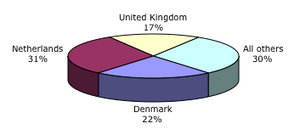
Culture
A smoke cooked plaice is one of the traditional summer time delicacies of Hiiumaa island.
American plaice
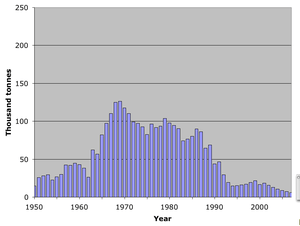
|
|
Like the European plaice, the American plaice is a right eyed flatfish belonging to the Pleuronectidae family. American plaice are an Atlantic species,[9] which range from southern Labrador to Rhode Island. They are also found in Europe, where they are called rough dab or long rough dab. They spawn in the Gulf of Maine, with peak activity in April and May. They are brown or reddish, and are generally smaller than European plaice, with a rougher skin and larger scales. Their maximum recorded length is 82.6 cm (32.5 inches), and maximum reported age 30 years. They are usually found between depths of 90 metres and 250 metres, on sandy bottoms with temperatures between -0.5 and 2.5°C. They feed on small fishes and invertebrates.[10][11]
The species is considered by the Northwest Atlantic Fisheries Organization to be overfished, with no signs of recovery.[12] Though they are also currently endangered in Canada due to overfishing,[13] the Canadian government believes the species is abundant. Plaice is the second most caught flatfish in Canada, accounting for 50 percent of all flatfish caught.[14]
American plaice may be an intermediate host for the nematode parasite Otostrongylus circumlitis, which is a lungworm of seals, primarily affecting animals less than 1 year of age.[15]
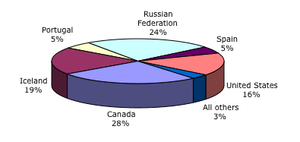
Alaska plaice
Alaska plaice can live for up to 30 years and grow to 60 centimetres (24 inches) long, but most that get caught are only seven or eight years old, and about 30 cm (12 in).[17]
Most commercial fisheries do not target Alaska plaice, but many are caught as bycatch by commercial trawlers trying to catch other bottom fish. Thus, many Alaska plaice get caught anyway - so much so that, for example, the 2005 total allowable catch in the Bering Sea and Aleutian Islands management area (BSAI) was reached before the end of May of that year.
Scale-eye plaice
The scale-eye plaice is a flatfish of the family Pleuronectidae. It is a demersal fish that lives at depths from between 18 metres (59 ft) to 900 metres (3,000 ft). It can reach 46 centimetres (18 in) in length and can weigh up to 1.2 kilograms (2.6 lb). Its native habitat is the northern Pacific, primarily from the Sea of Okhotsk to Japan and Korea, though it is also found in the Bering Sea.[18]
Plaice as a food
In North German and Danish cuisine plaice is one of the most commonly eaten fish. Filleted, battered, and pan-fried plaice is popular hot or cold as an open sandwich topping together with remoulade sauce and lemon slices. Battered plaice can also be served hot with french fries and remoulade sauce as a main dish; this fish and chips variant is commonly available as a children's special in Danish restaurants. Breaded frozen plaice, ready to be baked or fried at home, are readily available in supermarkets. Fresh plaice is also oven-baked.
"The flesh of plaice is white, tender and subtle-flavoured."[5] Plaice is sometimes used as the fish in fish and chips, in countries where the dish is popular.[19]
Current status
Plaice, along with the other major demersal fish in the North Sea such as cod, monkfish and sole, is listed by the ICES as "outside safe biological limits." Moreover, they are growing less quickly now and are rarely older than six years, whereas they can reach forty.[20] The World Wide Fund for Nature says that in 2006 that "of the eight plaice stocks recognised by ICES, only one is considered to be harvested sustainably while three are overexploited. Data is insufficient to assess the remaining stocks; however, landings for all stocks are at or near historical lows."[21]
Notes
- ↑ "Plaice". Webster's New World College Dictionary. Wiley Publishing. 2009.
- ↑ FAO: Species Fact Sheets: Pleuronectes platessa, Retrieved 23 November 2009.
- ↑ Froese, Rainer and Pauly, Daniel, eds. (2009). "Pleuronectes platessa" in FishBase. November 2009 version.
- ↑ European plaice and sole World Wide Fund for Nature. Retrieved 22 November 2009.
- 1 2 Plaice Marine Stewardship Council. Retrieved 22 November 2009.
- ↑ C.Michael Hogan. 2011. Celtic Sea. eds. P.Saundry & C.Cleveland. Encyclopedia of Earth. National Council for Science and the Environment. Washington DC.
- ↑ FAO Nominal Catches of Pleuronectes platessa FishBase, Retrieved 23 November 2009
- ↑ FAO: Species Fact Sheets: Hippoglossoides platessoides, Retrieved 23 November 2009.
- ↑ "Plaice." Grolier Encyclopedia of Knowledge, volume 15, copyright 1991. Grolier Inc., ISBN 0-7172-5300-7
- ↑ Dery, L.M. "American plaice, Hippoglossoides platessoides." Fishery Biology Program, Woods Hole Massachusetts Laboratory of the National Marine Fisheries Service (NMFS), Northeast Fisheries Science Center (NEFSC).retrieved January 18, 2007
- ↑ Froese, Rainer and Pauly, Daniel, eds. (2009). "Hippoglossoides platessoides" in FishBase. November 2009 version.
- ↑ Fishery Recent Assessment (2005 and 2006). Northwest Atlantic Fisheries Organization. retrieved January 18, 2007
- ↑ Bergeron et al. 1997. Canadian Journal of Zoology 75: 1364-1371.
- ↑ "American plaice." Underwater World. Fisheries and Oceans Canada. retrieved January 18, 2007
- ↑ Bergeron et al. 1997. Canadian Journal of Zoology 75: 1364-1371.
- ↑ FAO Nominal Catches of Hippoglossoides platessoides FishBase, Retrieved 23 November 2009
- ↑ Froese, Rainer and Pauly, Daniel, eds. (2009). "Pleuronectes quadrituberculatus" in FishBase. November 2009 version.
- ↑ Froese, Rainer and Pauly, Daniel, eds. (2009). "Acanthopsetta nadeshnyi" in FishBase. November 2009 version.
- ↑ Seafish. On Plate. Fish & chips
- ↑ Clover, Charles. 2004. The End of the Line: How overfishing is changing the world and what we eat. Ebury Press, London. ISBN 0-09-189780-7
- ↑ "European plaice and sole"
References
- Rijnsdorp, A.D. (1991) Changes in fecundity of female North Sea plaice (Pleuronectes platessa) between three periods since 1900. ICES Journal of Marine Science; 48: 253-280
- Wimpenny, R.S. (1953) The plaice being the buckland lectures. Publisher Edward Arnold
- Gibson, R.N. (2004) Flatfishes: Biology and Exploitation. Blackwell Publishing
- Clover, Charles. 2004. The End of the Line: How overfishing is changing the world and what we eat. Ebury Press, London. ISBN 0-09-189780-7
- 1998 Marine Fisheries Review article
- Bulletin announcing reaching the total allowable catch of Alaska plaice for 2005 (National Marine Fisheries Service)
External links
- Guide to Responsible Sourcing of Plaice - produced by Seafish http://www.seafish.org/upload/file/fisheries_management/Plaice%20Factsheet2%20%20final.pdf
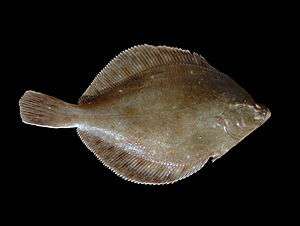

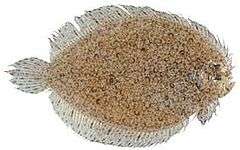
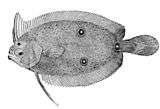
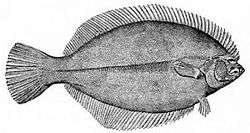
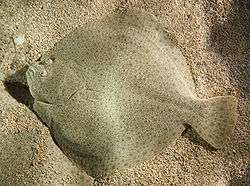
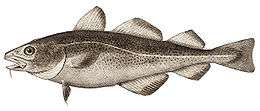
.png)
